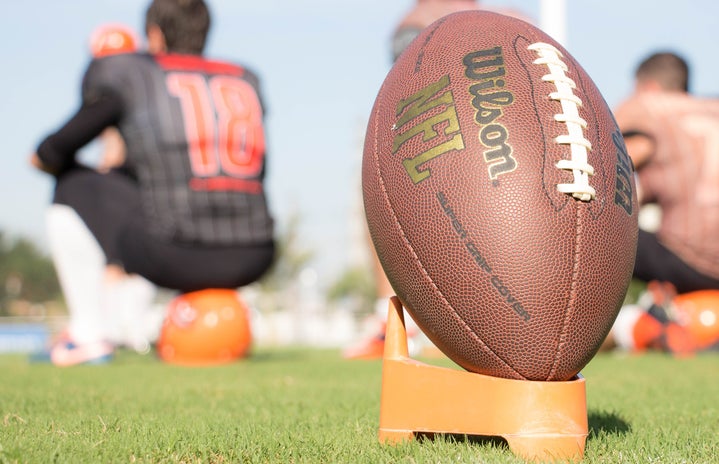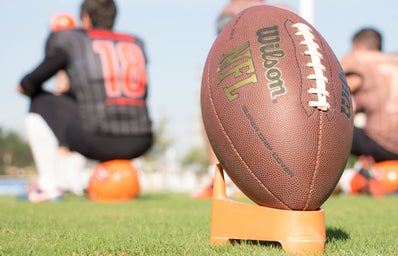In 2023, it is impossible to ignore Taylor Swift’s global influence. From her renowned album re-records to the recent premiere of her concert tour’s feature film, Blondie persistently lingers at the top of streaming charts and now the box office. Alongside her success, Swift has recently made headlines at a news outlet she had yet to permeate: ESPN.
Taylor Swift’s most recent relationship is unlike any of her past. Straying from her typical choice of actors and musicians, she has begun to date Travis Kelce. Over the past month, Swift has been documented enjoying her spot in the VIP suite of Arrowhead Stadium. Her new identity as a “WAG” (Wife and Girlfriend of an Athlete) has inspired many Swifties to take up an unforeseen interest in football. In fact, Travis Kelce’s jersey sales have increased by nearly 400% since their relationship went public, according to both NPR and ESPN.
Though football is not a traditionally feminine sport, I love seeing increasing numbers of women enjoying the sport. So, just in time for the Chiefs’ home game this Sunday, I decided to break football down into its basic concepts for the Swifties. Once the information is concise and accessible for all, many more will be able to partake in the fun. As Taylor Swift herself sings, “tis the damn season!”
Basic Gameplay
At any given time, eleven players from each team are on the field. Those on offense have the goal of “gaining yards” in an attempt to score a touchdown. Players on defense are tasked with tackling the offensive player with possession of the ball to prevent them from moving forward.
Gameplay is measured in “downs.”- individual downs are measured from the first movement of the ball to when the player with possession is tackled. The offensive players are allotted four downs to move the ball forward. With every 10 yards that offense moves the ball forward, the count resets and is called a “1st down.” Once the fourth down is reached or a touchdown is completed, possession is transferred to the other team and the players switch out.
At a fourth down, the opposing team has the choice of either punting the ball or attempting a field goal. If the offense is within 16-60 yards of the endzone, the team will likely attempt a field goal to score 3 points. Otherwise, the team will punt the ball so that when the other team is transferred possession they have to start further back.
A touchdown is worth 6 points. However, teams are offered the option to attempt a 1 or 2 point conversion in addition. A 1-point conversion is gained when the team kicks a successful field goal, and a 2-point conversion is gained when the team successfully runs an additional play 3 yards away from the endzone.
positions
offense
The players closest to the yard line are referred to as the offensive line, or O-Line. On the offensive line, there is one center, two guards, two tackles, and one or two tight ends. The center snaps (throws from behind) the ball to the QB and blocks D-Line players for both passes and runs. The guards on either side of the center also block for both passes and runs. The two tackles on the outside of each guard, again, block for both passes and runs. The tight ends can both block and run out to catch passes and are positioned furthest outside on the line. This is Travis Kelce’s position!
Behind the offensive line, there is one quarterback, two wide receivers and one to two running backs. The QB is positioned behind the center and makes the choice for offense between a pass or a run. Because he is responsible for calling plays in the huddle, he leads all of the offense. He can choose to either run the ball on his own, pass to a tight end, running back, or receiver, but usually chooses to hand the ball off to a running back. Wide receivers usually run out to catch passes from the QB and are positioned furthest outside to accomplish this. Running backs– often positioned behind the QB–can catch the ball on passes. However, they most frequently run the ball from behind the O-Line.
Defense
The players facing the offensive line are called the defensive line, or D-Line. On the D-Line, there are two defensive tackles and two defensive ends. Defensive tackles are the innermost players and their main goal is to rush the passer and move through offensive gaps to disrupt the play. Defensive ends are outside of the tackles and they are tasked to keep the play inside to prevent runs.
Additionally, there are three linebackers – one middle and two outside – two cornerbacks, and two safeties. The linebackers are immediately behind the D-Line and are tasked with stopping the offense’s motion. The cornerbacks are outside of the D-Line and are tasked with guarding the wide receivers. The safeties are the last line of defense and are closest to the goal line. Their job is to prevent any offensive motion not previously stopped by their teammates.
Special teams
In addition to defense and offense, there are five other teams of 11 that serve select purposes on the field. The field goal team enters the field to kick field goals and extra points. The kickoff team is tasked with kicking the ball to the other team after a transfer of possession. The kick-return team receives that kick from the other team. A kickoff occurs at the beginning of each half and after each score (touchdown or field goal). The punt team punts the ball to the other team, and the punt-return team receives it. A punt occurs when there is a transfer of possession after a scoreless fourth down.
Miscellaneous
Possession: Whichever team/player is holding the ball.
Plays: Organized strategies intended to disrupt the opposing team’s players. Both offense and defense employ plays, but they have vastly different purposes. Offensive plays are designed to gain yardage
Sack: When the QB is tackled before throwing the ball.
Interception: When the ball is passed but caught by a member of the opposing team.
Fumble: When a player misses or drops a pass.
Out of Bounds: When a player steps outside of the boundary of the field, out of bounds is called and the play halts.


